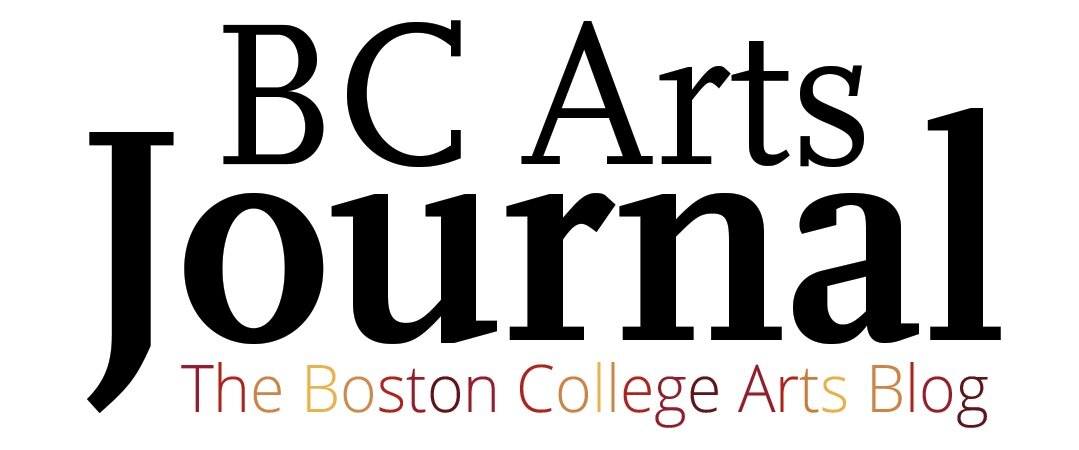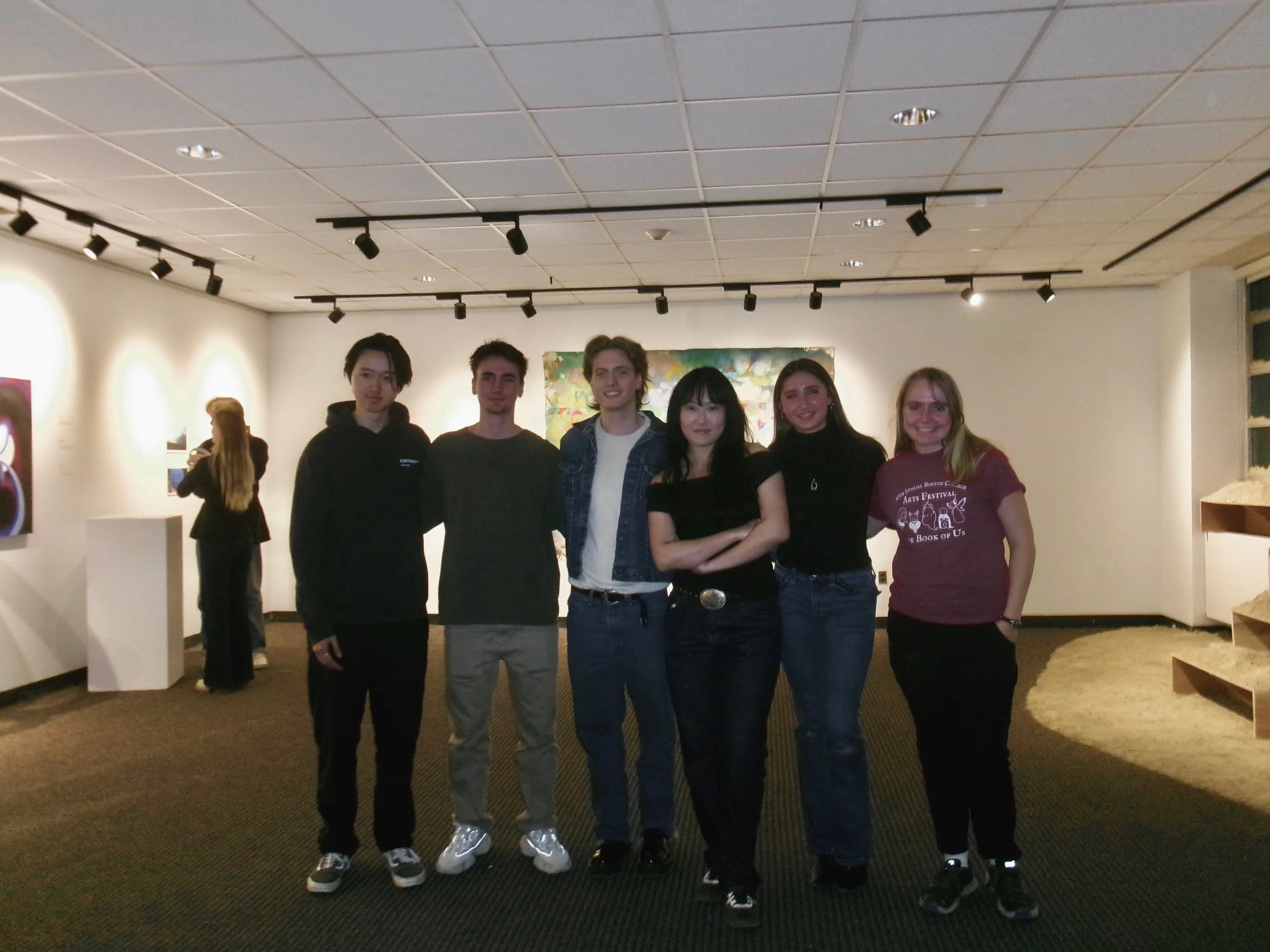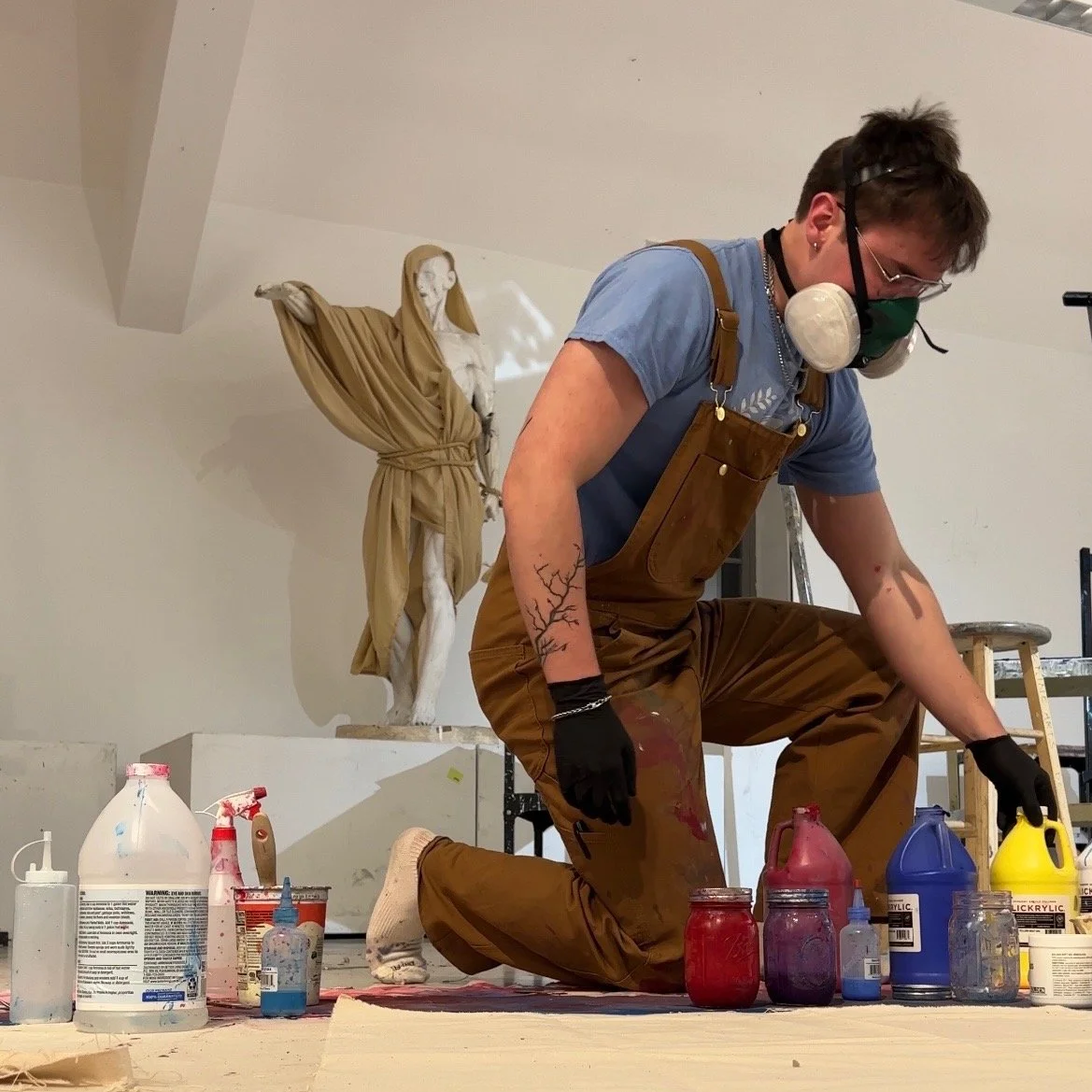On the Rise: A Conversation with Emerging Artist Marko Grgurevich
Artist Marko Grgurevich on the opening night of Emergence, in front of his show-stopping piece, Archaefructus.
Marko Grgurevich, professionally known as Simeon Marko, is an emerging artist and Studio Art major at Boston College who has quickly established himself as a standout talent within the university’s creative community. His work was recently showcased in the Art Council’s Emergence exhibition in November 2024, a show dedicated to spotlighting the innovative voices of Boston College artists.
Marko, can you talk a little about your upbringing? Where are you from?
Well, I was born in Tennessee, but I’ve lived in Massachusetts my whole life. The four seasons are nice, but I don’t see myself living here for much longer. It’s hard to pinpoint any particular inspiration; I mean, I consider everything I can remember to be an inspiration. My parents are both scientists, and I spent the majority of my childhood in a STEM school that didn’t have much of an art program. I never had any formal training until I came to college. But I think this was important as my love for the arts was something I cultivated on my own, not something I was taught. Even art school can suffocate creative spirit.
Where did your passion for the arts come from?
It seems like something that has always been with me. Ever since I can remember, I’ve always been drawing on anything I could get my hands on. I used to get in trouble for drawing on the desks in school and would stay up during nap time to give mustaches and hats to the animals printed on my cot. In 5th grade, I was getting commissions from my classmates to draw pictures for a couple of bucks. Soon I partnered with one of my buddies, and we started selling sh*tty photocopies of my art that we made on his printer. We even ran promotional campaigns by putting ads in people's lockers. This only lasted a few months, but it was a nice introduction to art sales.
However, as I got older, I was spending less and less time making art as I became more interested in the other things that kids do. I was a sophomore in high school when COVID hit, and like many others, I spent a lot of time reflecting on what I wanted to do with my life. Mentally, this was a very low point for me, so I began drawing more to try and reconnect with the passion that guided me in the past. I started posting my work on social media and slowly grew a small following. I got a bunch of painting supplies for my 17th birthday, and very quickly, this became my medium of choice. A few months later, I sold my first painting, and at that point, I knew that it was possible to make a career out of this. Since then, I have decided to dedicate my life to creating art.
Can you tell us a little about your artwork and how you would identify yourself with the artwork?
I've always viewed making art as a collaboration with something greater than myself. I don't like to make work that is strictly about me because I think identity is inherent in everything we create. And I don't make art with a specific purpose or intention because this is something that artists actually have little control over. When you put a work of art into the world, it takes on a life of its own in a way. My personal relationship with my art is different from my audiences. For one, it's impossible for me to look at my art objectively. But also (for me) art is all about the act of creating– the physical process of bringing something to life with my own hands. It's not about an end goal or some type of solution. A series is like a chapter and an artwork is like a page within the creative journey.
The artists featured in Emergence, the November exhibition at Gallery 203, pose together on opening night. From left to right: Eric Yu, Marko Grgurevich, Nick Vye, Pengyan ‘Max’ Zhu, Elena Sichel, and Margaret Ryan. The group stands against a backdrop of their work.
You recently participated in the Emergence show, which highlighted some of Boston College’s most prominent up and coming artists. How did it feel to showcase your work amongst your fellow peers?
It was a great experience, I especially enjoyed getting to meet so many new people. This show gave me the opportunity to interact with a lot of creatives at Boston College, and it was very interesting to hear about my peers' approaches to making art. I also got to learn about the behind-the-scenes of installing a show. Over the past year, I was really honed in on creating a solid body of quality work rather than reaching out and marketing myself, so I think it was a nice change of pace. Though I was hesitant at first, I am really glad I got to be part of the show.
Can you share the process of one of your most recent works, Archaefructus ,which is acrylic on unstretched canvas, shown in the Emergence show?
In this piece, which is part of my SAPOVNELA series, I moved back and forth between physical and digital modes of creation, including drawing, AI generation, digital manipulation, and painting. In the beginning, I used AI to generate images of flower fields, which I used as a reference for a physical drawing. I would not directly copy the image; rather, I used it as a guide for a very loose, intuitive sketch. I would further refine and manipulate this drawing digitally, adding color and glitched computer effects until I had an image that I liked. In order to fully realize the image, I created a large-scale painting of it, embracing the chaotic drips and imperfect edges that the real world provides. Ultimately, I wanted to create something that does not exist in our physical space or a digital one but in a symbiosis of infinite potential.
Have you ever explored other mediums aside from painting? If so how did that experience shape you as an artist?
As I outlined in my process for Archaefructus, I utilize many different mediums in my personal practice. While the final product is almost always a painting, at different points of the process, I may be a draftsman, printmaker, carpenter, and digital designer, just to name a few. I would like to note that I am not an expert in any of these subjects; I am more interested in how they can connect with one another and push the limits of what painting can be. While I see the importance of upholding traditional painting techniques (which have greatly influenced my work), I am focused on developing new modes of creation. So, even though I make paintings, I don't like to call myself a painter. Right now, I am focused on the 2d surface, but I can see myself expanding to more sculpture/installation-based work in the future.
How do you approach challenges or limitations—whether technical, conceptual, or external—when creating your art? Do you see them as obstacles or opportunities?
I've always thought that a great artist is never limited by their environment. In fact, I think limitation is what makes great art. Everything we experience in life is limited– if we lived forever and could do anything we wanted, nothing would have any value. To be truly meaningful, art must embrace this, turning limitation into an advantage. With every large project I take on, I always challenge myself to achieve more than what I am currently capable of. This requires a lot of trial and error and some days; it can definitely get difficult when it seems like nothing is going the way you want it to. But I never like to think of this as a failure because creating art is not about right or wrong– it's an exploration. It's necessary to have a goal to provide direction, but achieving that goal is not so important. So, as long as you are creating, you are always moving forward.
The art world can sometimes feel inaccessible to those without connections or resources. Do you think this is changing, and how can the industry become more inclusive?
The unfortunate reality is that there are very few artists within the fine art world who can live comfortably off of their art. Most artists need to charge a lot for their work because they produce a very limited amount each year. This alienates the majority, who cannot afford to spend that much on art, so they need to find their way into the small circle of wealthy collectors to survive. Since art is largely subjective, becoming a part of this circle is more about who you know rather than the merit of the work. Wealthy collectors and galleries are very particular about what they buy, often sticking to well-known artists rather than taking a risk on emerging faces. It has been this way for a long time and, sadly, has not changed much. However, art has also never been more accessible, and it is possible for almost anyone to share their work with the world. Even if you don't have access to high-quality paints and canvas, you can make great art from anything you find around you. Many artists have made careers from doing this. Also, artists do not have to be limited to the field of fine art; there are so many industries in fashion, merchandising, and graphic design where art skills can be used to make a career. Still, I think we need to place a greater emphasis on supporting local artists. Instead of buying a print of some million-dollar artwork from someone dead, buy an original piece from someone you know. Making a career out of art will always be difficult, but I think it's important to remember that the act of creating is a reward in itself.
Bouquet Lindelli by Marko Grgurevich
As the year comes to an end, is there anything you plan to continue working on or want to shift your focus into?
Over the past few months, I've been developing a process of using thin lines of red, green, blue, and black to create paintings that emulate the way LED screens make color with light. This idea stemmed from my SAPOVNELA series, as I became fascinated by the small RGB "glitches" that emerged from the digital manipulations of my flowers. Translating these glitches into my painting proved to be very challenging, and I played with different paint mixtures, line widths, and application methods in each piece of the series. For the final piece, Bouquet Lindelli, I attempted to create an image entirely out of RGB lines, and the result was beyond anything I could imagine. However, this piece is small and on paper, and my goal is to make large-scale paintings on canvas. For Bouquet Lindelli, I used a custom laser-cut acrylic stencil, but recently, I've been experimenting with screen printing because of its consistency and scalability. I see a lot of potential in this RGB system, and I look forward to sharing what I create with it.
A massive thank-you to Marko Grgurevich for not only participating in our Emergence show but also contributing to this article. It has been a personal pleasure working with Marko on Emergence. His dedication to the arts and the respect he shows his colleagues and friends are deeply admirable.
Marko is an incredible artist, and I’m excited to see where his journey takes him next. You can support him by following his Instagram, @simeon.marko, purchasing his art directly, and attending his upcoming shows.
Article Written By Brooke Olson
Photos Provided by Arts Council and Marko Grgurevich




